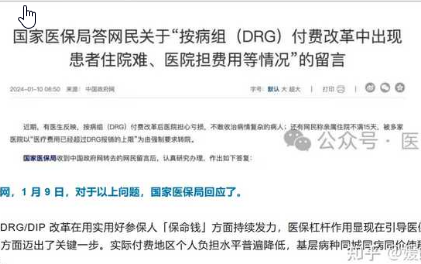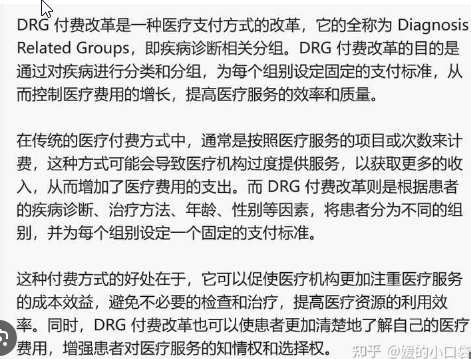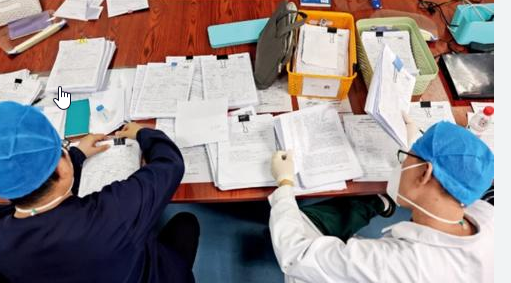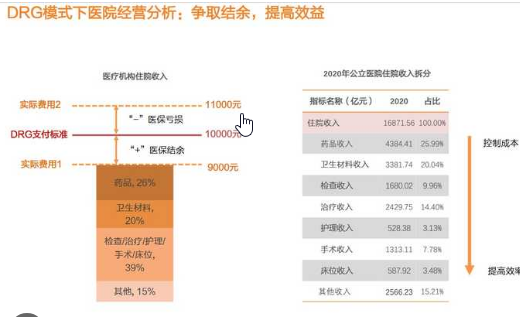 简体中文
简体中文
 Russian
Russian
“After working hard for a month, the department deducted money after calculation.” “The patient’s main complaint was just a common disease, but after checking, he found multiple comorbidities. This is embarrassing!” According to reports, many provinces and cities have recently reformed the system of classifying diseases according to disease. After diagnosis-related group (DRG) payment, the growth of medical expenses has been significantly controlled, but new situations have followed: some medical institutions are unwilling to accept complex patients. "Complex patients need to deal with a lot of steps, and the cost after benchmarking with DRG is obviously excessive. According to the existing medical insurance regulations, in reality, doctors often have to pay back after doing the hard work." Industry insiders confided.
Regardless of whether the patient's condition is simple or complex, he or she deserves appropriate diagnosis and treatment. Only when the insured pays premiums when they are not sick, use them sparingly when they are suffering from minor illnesses, and use them extensively when they are seriously ill can the role of mutual medical insurance protection be maximized. Moreover, the more complex and critical the illness, the greater the scope and amount of reimbursement. This is basic common sense and the biggest reason for insured people to feel at ease. If a hospital takes advantage of the easy and avoids the serious, or explicitly or covertly refuses to admit complex patients, it goes against the original intention of the medical insurance system, and it will be the seriously ill patients who will ultimately suffer.
On the other hand, hospitals seem to have difficulties with this phenomenon. It is not only entirely possible that the reform of medical insurance payment methods will lead to department losses, but it is also sometimes very common. Because diseases in the same group will receive the same amount of medical insurance payment, but two patients whose diseases are in the same group may require very different diagnosis and treatment. The department can earn corresponding profits from ordinary patients, but "complex patients" require more examinations and medication. If there are too many, the department may actually suffer a large loss. In order to avoid cheating and make as much money as possible, departments will select patients.
In addition, the reform of medical insurance payment methods is also imperative. We cannot shrink from progress because of problems, causing the reform to be abandoned halfway. In the past, simply paying according to the project meant that the more projects were done, the more the charges would be. Allowing patients to have as many examinations and take more medicines as possible has become a common method for hospitals to increase revenue. Payment based on diagnosis-related groups (DRG) is different. This payment method has a lump sum nature. When included in the group, medical insurance payments are basically fixed. The more examinations and medications a patient takes, the lower the hospital's profits will be. This reform can transform some doctors from implementers of over-diagnosis and treatment into opponents of over-diagnosis and treatment.
It can be seen that the views of many parties are understandable and worth listening to, indicating that the reform of medical insurance payment methods is correct in major aspects, but the detailed design can continue to be improved. For example, when two patients with the same disease group need very different diagnosis and treatment, it means that the grouping is unreasonable. Especially when the patients have multiple comorbidities, similar uncertain changes will make the situation even worse. It’s complicated, and scientific and reasonable response measures are needed.
It is normal to pay according to disease type to have both losses and profits. The hospital should foresee this, as long as it is possible to obtain sufficient profits as a whole. Hospitals should not view profits and losses in a one-sided manner on a case-by-case basis, and should understand the reasonable losses of a single patient. They should not pursue the idea of making a steady profit, or even reject complex patients on the grounds of possible losses. Details determine success or failure. The top priority is to delve into every detail of group payment, further optimize reform measures, and conduct detailed tracking and analysis of hospital revenue to continuously optimize the rules.
Medical reform often affects the whole body, and positive and negative effects follow closely. A good doctor must first consider the toxic and side effects of the drug when using medicine, and then consider the therapeutic effect. For good medical reform, we must first prevent side effects and then consider the positive effects. From this point of view, the reform of medical insurance payment methods must adhere to the idea of step by step, and advance one step at a time when it is mature. It is better to slow down the pace when it is not yet mature. It is better for the reform to be slower than to make patients generally pay the price, let alone to let patients pay the price. Complex patients who originally required more careful diagnosis and treatment became victims due to unreasonable design of some details.

Woman was robbed of money box by law enforcement officers wh
Woman was robbed of money box by law enforcement officers wh...(645 )人阅读时间:2024-04-28
Children in Hangzhou are on spring break
Children in Hangzhou are on spring breakOn April 28, primary...(954 )人阅读时间:2024-04-28
Woman paralyzed in car accident, brother takes care of her f
Woman paralyzed in car accident, brother takes care of her f...(737 )人阅读时间:2024-04-28
Before his death, the grandfather told the surveillance came
Before his death, the grandfather told the surveillance came...(1036 )人阅读时间:2024-04-28Woman paralyzed in car accident, brother takes care of her f
 Woman paralyzed in car accident, brother takes care of her f...2024-04-28
Woman paralyzed in car accident, brother takes care of her f...2024-04-28Yang Xiaoming is suspected of serious violations of discipli
 Yang Xiaoming is suspected of serious violations of discipli...2024-04-28
Yang Xiaoming is suspected of serious violations of discipli...2024-04-28Suspected of changing rides mid-ride, killing 16 cats of cus
 Suspected of changing rides mid-ride, killing 16 cats of cus...2024-04-28
Suspected of changing rides mid-ride, killing 16 cats of cus...2024-04-28Su Bingtian leads China's men's relay team to win gold
 Su Bingtian leads China's men's relay team to win go...2024-04-28
Su Bingtian leads China's men's relay team to win go...2024-04-28
Woman was robbed of money box by law enforcement officers wh

Children in Hangzhou are on spring break

Woman paralyzed in car accident, brother takes care of her f

Before his death, the grandfather told the surveillance came

The policeman who went into the village to call out the vill

Family members of the deceased in M7 fire accident in Wenjie